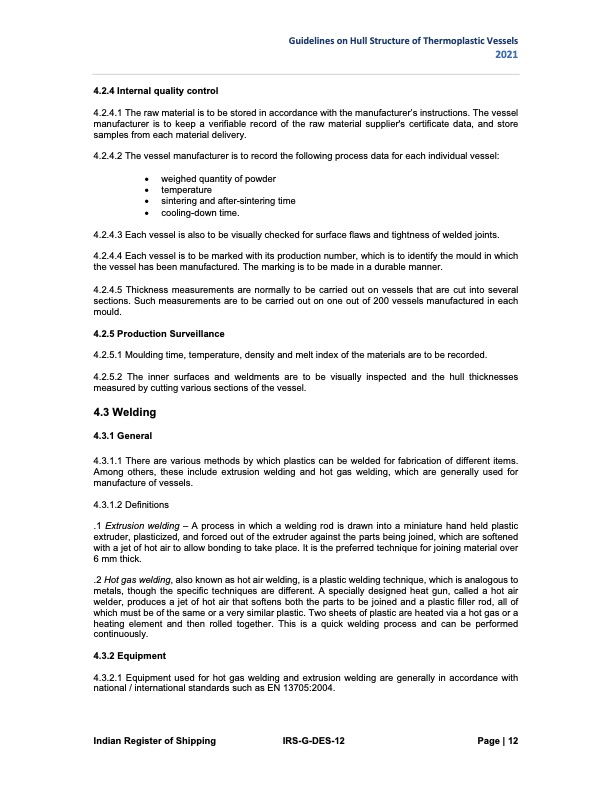
PDF Publication Title:
Text from PDF Page: 012
4.2.4 Internal quality control Guidelines on Hull Structure of Thermoplastic Vessels 2021 4.2.4.1 The raw material is to be stored in accordance with the manufacturer’s instructions. The vessel manufacturer is to keep a verifiable record of the raw material supplier's certificate data, and store samples from each material delivery. 4.2.4.2 The vessel manufacturer is to record the following process data for each individual vessel: weighed quantity of powder temperature sintering and after-sintering time cooling-down time. 4.2.4.3 Each vessel is also to be visually checked for surface flaws and tightness of welded joints. 4.2.4.4 Each vessel is to be marked with its production number, which is to identify the mould in which the vessel has been manufactured. The marking is to be made in a durable manner. 4.2.4.5 Thickness measurements are normally to be carried out on vessels that are cut into several sections. Such measurements are to be carried out on one out of 200 vessels manufactured in each mould. 4.2.5 Production Surveillance 4.2.5.1 Moulding time, temperature, density and melt index of the materials are to be recorded. 4.2.5.2 The inner surfaces and weldments are to be visually inspected and the hull thicknesses measured by cutting various sections of the vessel. 4.3 Welding 4.3.1 General 4.3.1.1 There are various methods by which plastics can be welded for fabrication of different items. Among others, these include extrusion welding and hot gas welding, which are generally used for manufacture of vessels. 4.3.1.2 Definitions .1 Extrusion welding – A process in which a welding rod is drawn into a miniature hand held plastic extruder, plasticized, and forced out of the extruder against the parts being joined, which are softened with a jet of hot air to allow bonding to take place. It is the preferred technique for joining material over 6 mm thick. .2 Hot gas welding, also known as hot air welding, is a plastic welding technique, which is analogous to metals, though the specific techniques are different. A specially designed heat gun, called a hot air welder, produces a jet of hot air that softens both the parts to be joined and a plastic filler rod, all of which must be of the same or a very similar plastic. Two sheets of plastic are heated via a hot gas or a heating element and then rolled together. This is a quick welding process and can be performed continuously. 4.3.2 Equipment 4.3.2.1 Equipment used for hot gas welding and extrusion welding are generally in accordance with national / international standards such as EN 13705:2004. Indian Register of Shipping IRS-G-DES-12 Page | 12PDF Image | Hull Structure of Thermoplastic Vessels 2021

PDF Search Title:
Hull Structure of Thermoplastic Vessels 2021Original File Name Searched:
guidelines-on-thermoplastic-boats.pdfDIY PDF Search: Google It | Yahoo | Bing
Development of a solar powered Electric Ship The Electricship website originally started off as a project to develop a comprehensive renewable, affordable, modular electric ship... More Info
Modular Boat Hull Composite The case for a unsinkable, modular composite hybrid boat hull... More Info
MS Burgenstock Hybrid Electric Catamaran Lake Lucerne Unique shuttle servicing Lucerne to the Burgenstock Resort... More Info
Ground Power Unit GPU Powered by Lithium Ion Batteries The goal of the Ground Power Unit is to provide a readily accessible, modular, ready-to-power solution for remote power... More Info
| CONTACT TEL: 608-238-6001 Email: greg@electricship.com | RSS | AMP |